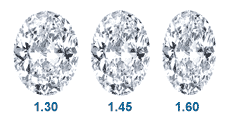Contact
Click below to speak to a Diamond Consultant or customer service.
or
Live Chat8:00 am - 6:00 pm CST (Mon - Fri)

Click below to speak to a Diamond Consultant or customer service.
or
Live Chat8:00 am - 6:00 pm CST (Mon - Fri)

Created by Lazare Kaplan in the 1960's, oval diamonds are a modified brilliant-cut (like virtually all round cuts). Because the two shapes possess a similar fire and brilliance, the oval is an ideal choice for a customer who likes the look of a round diamond, but wants something more unique. Oval diamonds have the added advantage of an elongated shape, which can create the illusion of greater size. The slender shape can also make the finger of the wearer appear longer and slimmer, an effect often desired.

Preferences vary on how narrow or fat an oval cut diamond should be, so choose what appeals to you personally (though a length to width ratio of 1.35 - 1.50 is considered the classic oval cut). A slightly thinner cut may look most appealing in a setting where the diamond is flanked by side stones. Every Lumera Diamond includes precise measurements, as well as the length to width ratio, so you know the exact shape of the oval diamond you are considering.
Oval cut diamonds posses some degree of bow-tie, varying from near invisible to severe. The visibility of a bow-tie effect cannot be ascertained by reviewing the diamond certificate or dimensions, but only upon visual inspection. If you are interested in purchasing an oval diamond, but would like to have it inspected first, please contact a diamond consultant, who can review diamonds on your behalf. chat online, or email [email protected].
The chart below serves as a general guideline for evaluating the cut of an oval diamond.
| EXCELLENT | VERY GOOD | GOOD | FAIR | POOR | |
|---|---|---|---|---|---|
| Table % | 53 - 63 |
52
or 64 - 65 |
51
or 66 - 68 |
50
or 69 - 70 |
< 50
or > 70 |
| Depth % | 58 - 62 |
56 - 57.9
or 62.1 - 66 |
53 - 55.9
or 66.1 - 71 |
50 - 52.9
or 71.1 - 74 |
< 50
or > 74 |
| Girdle | Very Thin - Slightly Thick |
Very Thin
to Thick |
Very Thin
to Very Thick |
Ex. Thin
to Ex. Thick |
|
| Culet | None | Very Small | Small | Medium | > Medium |
| L/W Ratio | 1.35 - 1.50 |
1.30 - 1.34
or 1.51 - 1.55 |
1.25 - 1.29
or 1.56 - 1.60 |
1.20 - 1.24
or 1.61 - 1.65 |
> 1.20
or < 1.65 |
Evaluating color in oval diamonds is subjective. Keep in mind that many buyers may actually prefer the ever so slightly warmer colors of a G-H diamond over the cool colorlessness of a D-F diamond. In fact, most of the premium in price associated with oval diamonds at the higher end of the color scale is driven by supply and demand; customers want the D-F color grades, and are willing to pay a premium to get them. In a world without diamond color grading, the price premium for higher grades would be much lower, as the actual differences in color are difficult to perceive. The color chart below provides a general guide for evaluating color in oval diamonds.
| EXCELLENT | VERY GOOD | GOOD | FAIR | POOR | |
|---|---|---|---|---|---|
| < .50 ct. | D - G | H - I | J - K | L - M | > M |
| .51-1.0 ct. | D - F | G | H - I | J - K | > K |
| 1.0-2.0 ct. | D - F | G - H | I - J | > J | |
| > 2.0 ct. | D - F | G | H - I | > I | |
| Fluoro | None | Faint - Med | Strong | Very Strong | |
Like color, evaluating clarity in oval diamonds is subjective. GIA provides excellent help with their clarity grades. Still, it is important to understand that each customer will have a unique standard for clarity. Some may be perfectly comfortable with an inclusion as long as they cannot easily see it. Others may insist on a more technically flawless appearance. The clarity chart below provides a general guide for evaluating clarity in oval diamonds.
| EXCELLENT | VERY GOOD | GOOD | FAIR | POOR | |
|---|---|---|---|---|---|
| < .50 ct. | FL - VS2 | SI1 - SI2 | I1 | I2 | > I2 |
| .51-1.0 ct. | FL - VS1 | VS2 - SI1 | SI2 | I1 - I2 | > I2 |
| 1.0-2.0 ct. | FL - VVS2 | VS1 - VS2 | SI1 - SI2 | I1 | > I1 |
| > 2.0 ct. | FL - VVS2 | VS1 - VS2 | SI1 | SI2 | > SI2 |
Questions about shape or other aspects of a diamond? Ask a diamond consultant for answers. A consultant will answer any questions you have, and if you like, search for diamonds on your behalf that match your criteria. chat online, or email [email protected].

